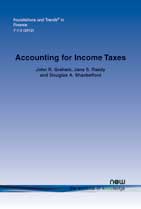Accounting for Income Taxes: Primer, Extant Research, and Future Directions
By John R. Graham, Duke University, USA, John.Graham@duke.edu | Jana S. Raedy, University of North Carolina at Chapel Hill, USA, Jana_Raedy@kenan-flagler.unc.edu | Douglas A. Shackelford, University of North Carolina at Chapel Hill, USA, Douglas_Shackelford@kenan-flagler.unc.edu
Abstract
This monograph comprehensively reviews the Accounting for Income Taxes (AFIT) literature. We begin by identifying four distinctive aspects of AFIT. We cover the rules surrounding AFIT and provide a discussion of the descriptive studies related to AFIT. We then review the existing research studies in detail and offer suggestions for future research. We focus on the two research questions that have been most widely studied (the extent to which managers use the tax accounts to manipulate earnings and whether equity market participants price the tax accounts). We discuss econometric issues that apply to AFIT and more broadly apply to much accounting and economics research. We also highlight areas that have not received much research attention and that warrant future analysis.
This review includes material that was originally published in Graham, J., Raedy, J., Shackelford, D., 2012, "Research in the Accounting for Income Taxes," Journal of Accounting and Economics. That publication and this one have benefited from outstanding research assistance by Justin Hopkins, Margot Howard, Hyunseob Kim, Kevin Markle, Jenna Meints, Jake Thornock, and Kelly Wentland and helpful comments from Jeff Abarbanell, Scott Dyreng, Jonathan Forman, Mary Margaret Frank, Ed Maydew, Lillian Mills, Richard Sansing, Casey Schwab, Jeri Seidman, Stephanie Sikes, Dan Taylor, Ross Watts, the Texas Tax Readings Group, and participants at the UNC Tax Symposium and the National Tax Association annual conference.
Accounting for Income Taxes: Primer, Extant Research, and Future Directions
Accounting for Income Taxes is the most comprehensive review of AFIT research. It is designed both to introduce new scholars to this field and to encourage active researchers to expand frontiers related to accounting for income taxes. Accounting for Income Taxes includes both a primer about the rules governing AFIT (Sections 3-4) and a review of the scholarly studies in the field (Sections 5-8). The primer uses accessible examples and clear language to express essential AFIT rules and institutional features. Section 3 reviews the basic rules and institutional details governing AFIT. Section 4 discusses ways that researchers, policymakers, and other interested parties can use the tax information in financial statements to better approximate information in the tax return. The second half of the monograph reviews the extant scholarly studies by splitting the research literature into four topics: earnings management, the association between book-tax differences and earnings characteristics, the equity market pricing of information in the tax accounts, and book-tax conformity. Section 5 focuses on the use of the tax accounts to manage earnings through the valuation allowance, the income tax contingency, and permanently reinvested foreign earnings. Section 6 discusses the association between book-tax differences and earnings characteristics, namely earnings growth and earnings persistence. Section 7 explores how tax information is reflected in share prices. Section 8 reviews the increased alignment of accounting for book purposes and tax purposes. The remainder of the paper focuses on topics of general interest in the economics and econometric literatures. Section 9 highlights some issues of general importance including a theoretical framework to interpret and guide empirical AFIT studies, the disaggregated components of book-tax differences and research opportunities as the U.S. moves toward International Financial Reporting Standards (IFRS). Section 10 discusses econometric weaknesses that are common in AFIT research and proposes ways to mitigate their deleterious effects.
